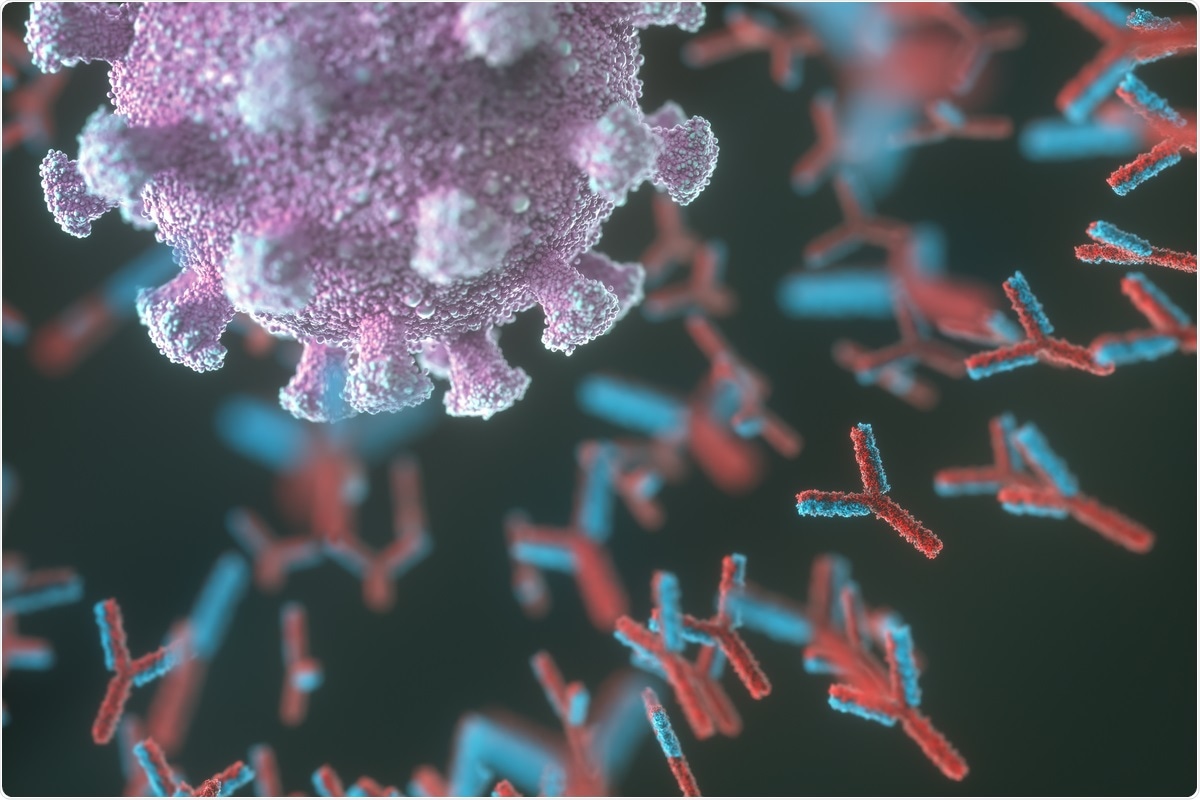Structural mechanism of anti-SARS-CoV-2 neutralizing antibodies that target separate spike epitopes

Since 2020, severe acute respiratory syndrome coronavirus 2 (SARS-CoV-2) variants have been an increasing threat globally. The first variant (the Alpha variant) was discovered in the UK and quickly became dominant globally. Since then, more and more variants have been discovered, including Beta, Gamma, and the variant that now accounts for over 90% of cases, the Delta variant.
 Study: Structural mechanism of SARS-CoV-2 neutralization by two murine antibodies targeting the RBD. Image Credit: ktsdesign/ Shutterstock
Study: Structural mechanism of SARS-CoV-2 neutralization by two murine antibodies targeting the RBD. Image Credit: ktsdesign/ Shutterstock
New variants are recognized by mutations of the highly glycosylated spike protein. This protein is largely responsible for the pathogenicity of SARS-CoV-2. The receptor-binding domain (RBD) within the N-terminal S1 subunit of the spike protein binds to the ACE2 receptors presented by human cells, allowing viral entry.
The alterations caused by the mutations to this protein can reduce the effectiveness of treatments such as monoclonal antibodies and lower the effectiveness of vaccines – both Pfizer and Moderna vaccines have shown up to a 12-fold drop in effectivity against the Beta variant.
In a paper published in Cell Reports, researchers from the Washington University School Of Medicine have identified how a subset of variants of concern (VOCs) can escape neutralization by two neutralizing antibodies – 2B04 and 2H04.
The study
The RBD has two observed conformations – 'up' and 'down.' As the spike protein is a trimer, this leads to four possible configurations for each spike protein – all up (UUU), all down (DDD), one up two down (UDD), or two up one down (UUD). Most of the trimers assume DDD or UDD – this is thought to be an evolutionary strategy to help evade the immune response. Some of the more infectious variants show more of the monomers assuming the up position, which allows for increased binding to ACE2.
The researchers examined two monoclonal antibodies, 2B04 and 2H04, that showed strong neutralization activity and used cryoelectron microscopy (cryo-EM) to characterize the epitopes these antibodies targeted. They further attempted to identify any viral mutations that could have occurred, leading to the viruses' ability to evade the neutralization of these antibodies.
The researchers first solved the structure of 2B04 bound to UDD conformation by collecting data from complexes frozen on lacey carbon grids covered by an ultra-thin carbon film. This allowed them to overcome the issues with using standard lacey carbon grids, which tended to show a strong top-down preferred orientation, preventing reliable model building. After also solving the structure of 2H04, they discovered it is normally bound to particles in the DDD conformation. However, both antibodies were able to bind to the spike protein regardless of RBD conformation.
.jpg) Graphical Abstract: Structural mechanism of SARS-CoV-2 neutralization by two murine antibodies targeting the RBD
Graphical Abstract: Structural mechanism of SARS-CoV-2 neutralization by two murine antibodies targeting the RBD
Using maps generated by local refinement, the scientists discovered the specific residues and strands that formed the interface of the complex for both monoclonal antibodies. 2B04 binds to the receptor-binding motif (RBM), with the heavy chain pressing against the loop of the RBM. The light chain also binds to the RBM, but most contacts are from the heavy chain. 2H04 binds to an area adjacent to the RBM, with both the heavy and light chain making contact with a loop.
To examine the virus' ability to escape neutralization from these antibodies, the scientists generated escape mutations with a pseudovirus under selective pressure from both antibodies. Several mutations occurred that, upon further examination, were identical to mutations that had occurred naturally. These mutations lie outside the ACE2 binding site and alter the epitope for 2H04 and 2B04. While not enough to prevent neutralization on their own, this shows a mechanism by which the virus could evolve to evade the host's immunity.
Conclusion
The researchers highlight the importance of their research in helping to advance our understanding of the epitopes targeted by antibodies produced against SARS-CoV-2. This information could be key in helping inform healthcare workers and in directing further research and drug development to aid against the pandemic.
Knowing both the mechanisms by which the antibodies can target SARS-CoV-2 and how it can evade that immunity could allow researchers to attempt to mimic the immune system's actions when creating new drugs, and knowing the evasion mechanisms could allow us to begin to act against new variants before they emerge. Producing treatments that will be successful against new strains of COVID-19 could be key to ending the pandemic, especially as mass vaccination schemes begin to stall around the world.
- Errico, JM. et al., (2021) Structural mechanism of SARS-CoV-2 neutralization by two murine antibodies targeting the RBD. Cell Reports. doi: https://doi.org/10.1016/j.celrep.2021.109881
Posted in: Medical Science News | Medical Research News | Disease/Infection News
Tags: ACE2, Antibodies, Coronavirus, Coronavirus Disease COVID-19, Drugs, Healthcare, Immune Response, Immune System, immunity, Medicine, Microscopy, Pandemic, Protein, Pseudovirus, Receptor, Research, Respiratory, SARS, SARS-CoV-2, Severe Acute Respiratory, Severe Acute Respiratory Syndrome, Spike Protein, Syndrome, Top-Down, Virus

Written by
Sam Hancock
Sam completed his MSci in Genetics at the University of Nottingham in 2019, fuelled initially by an interest in genetic ageing. As part of his degree, he also investigated the role of rnh genes in originless replication in archaea.
Source: Read Full Article